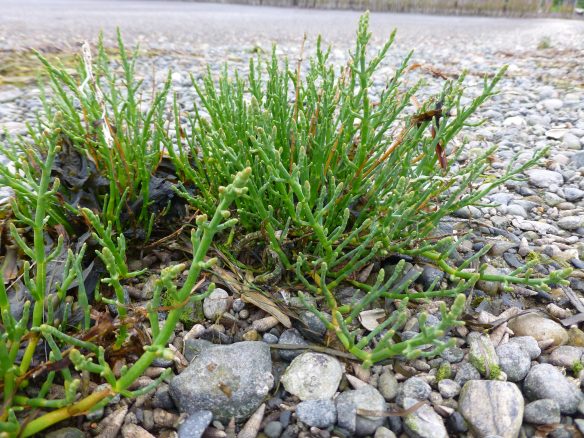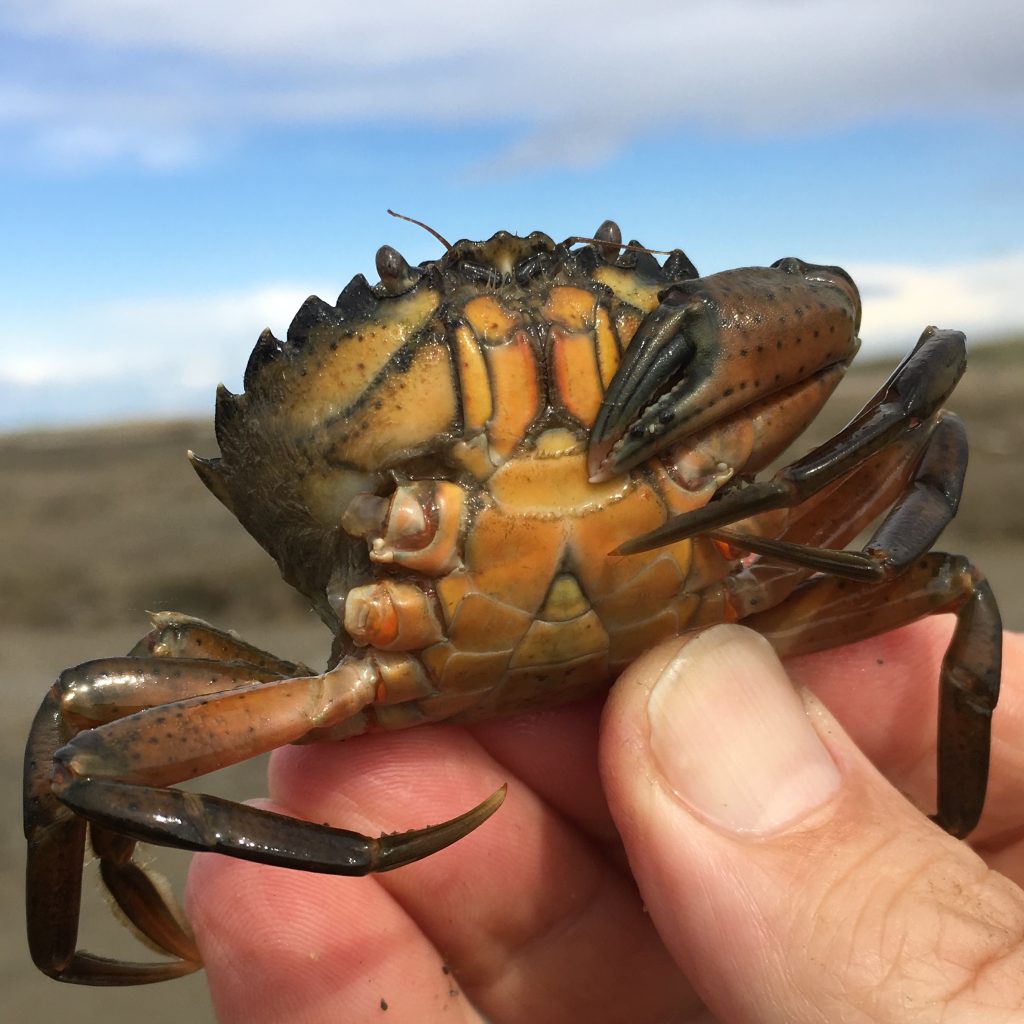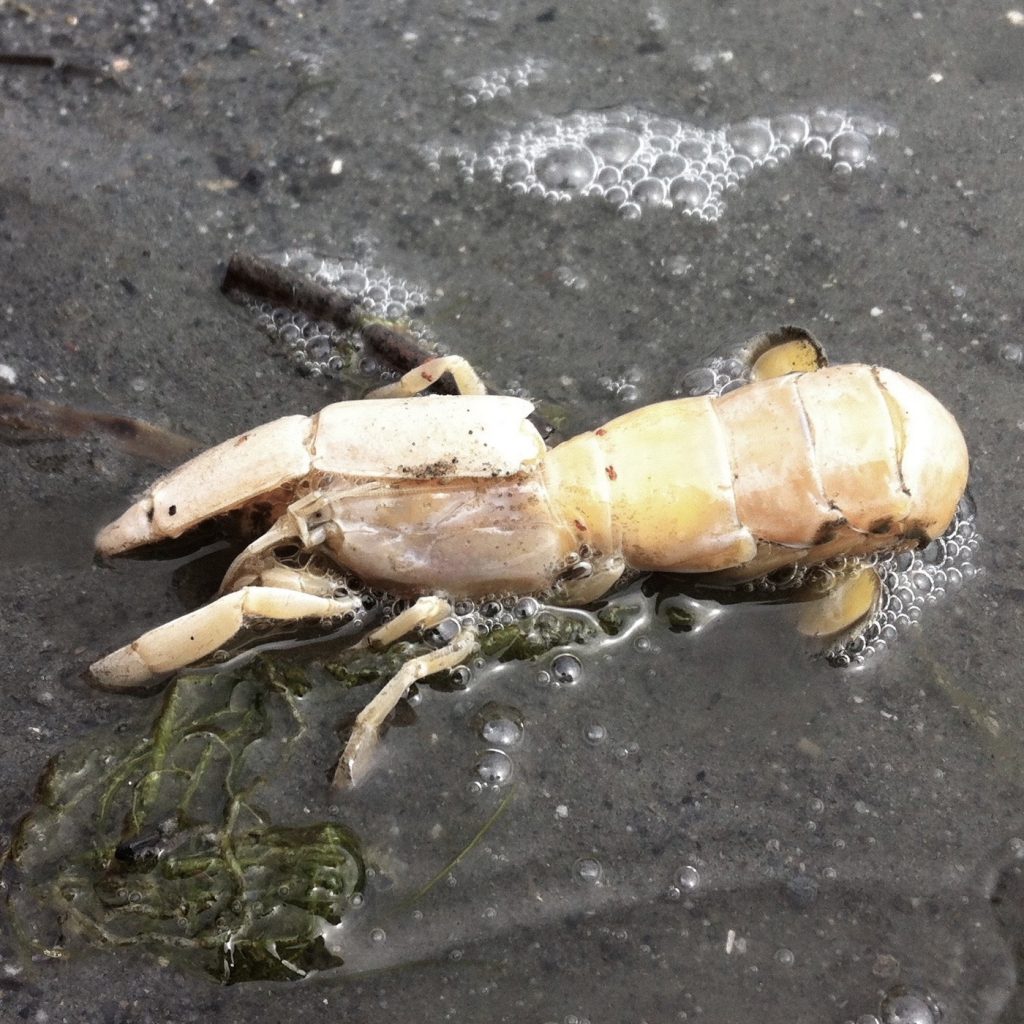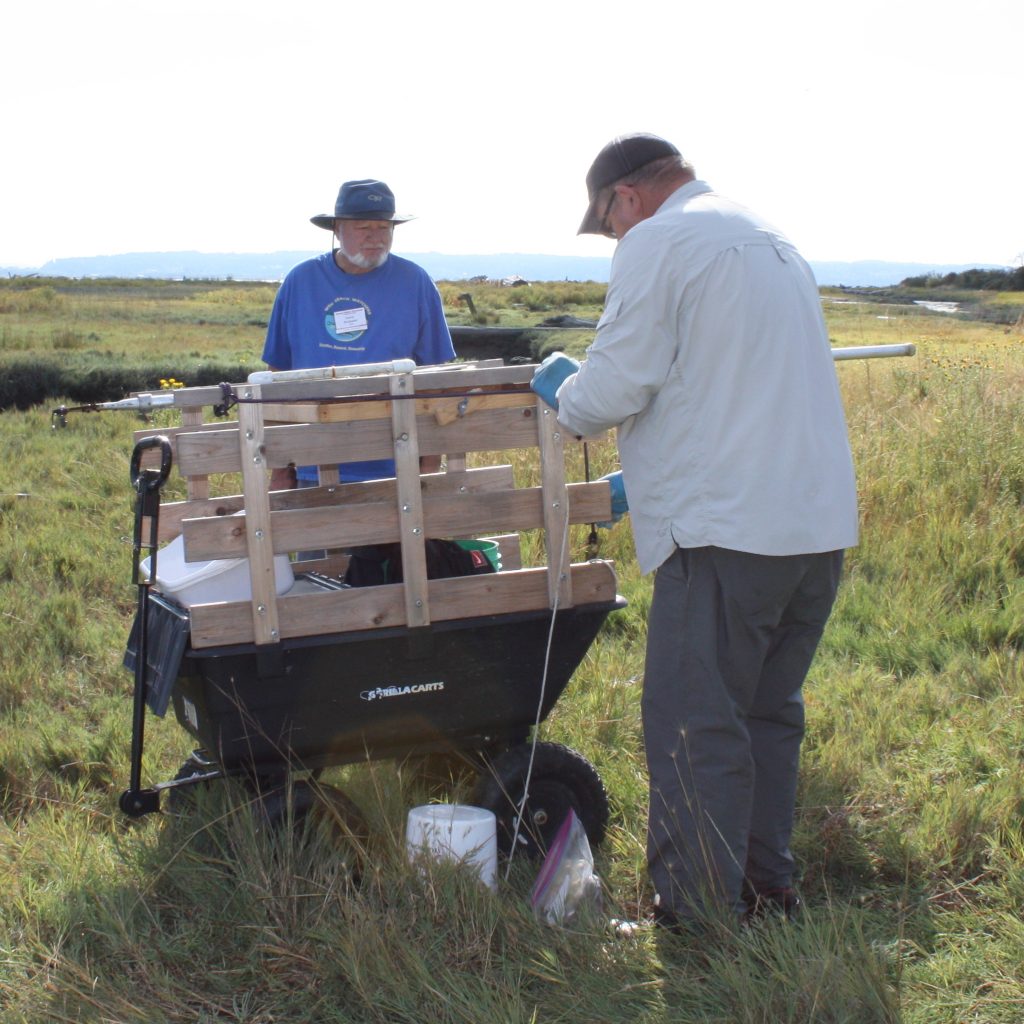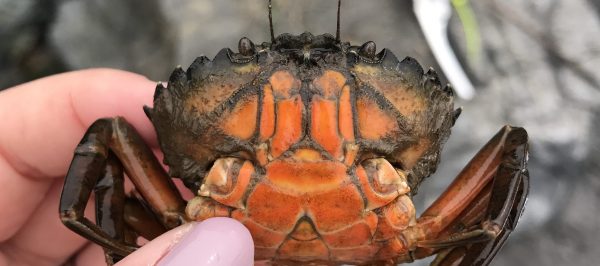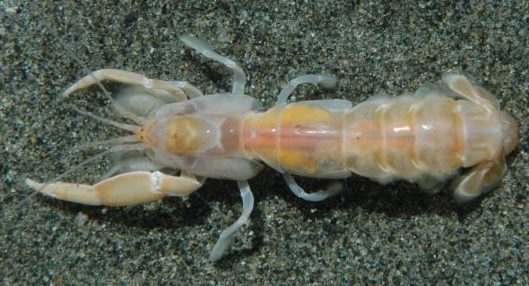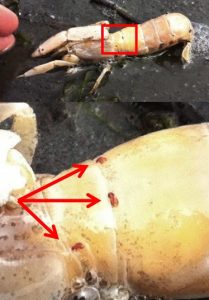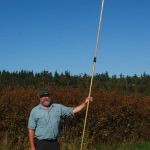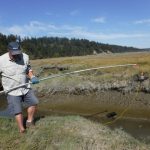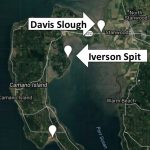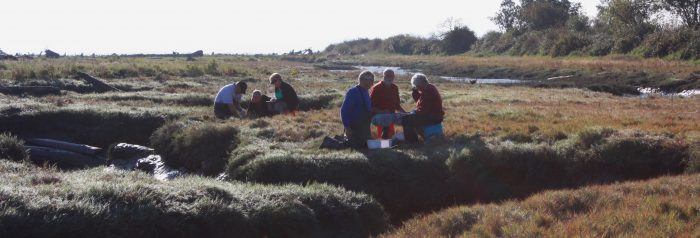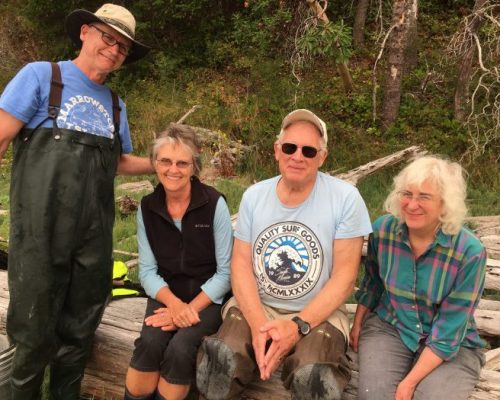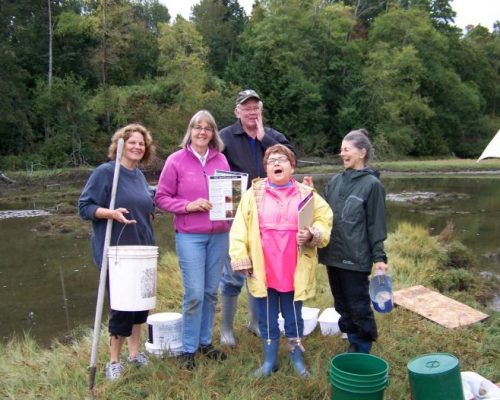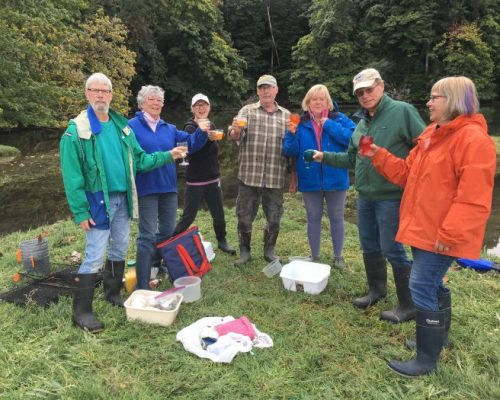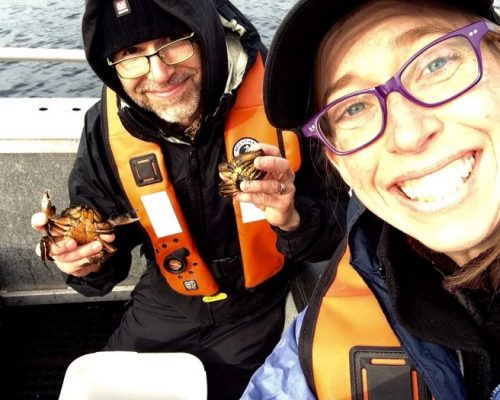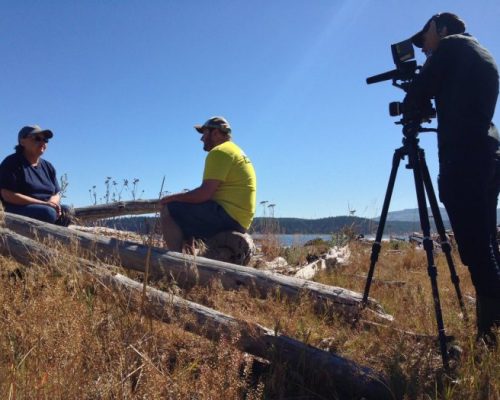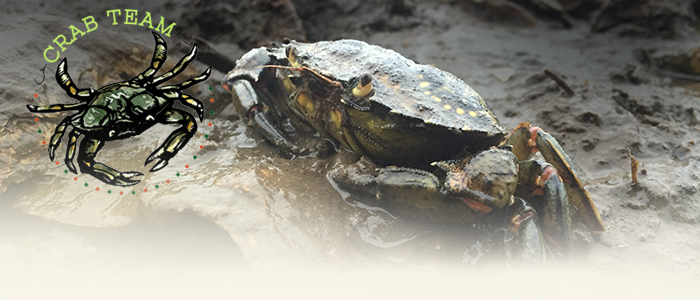
Wrapping up a busy year
November 21st, 2017
The 2017 Crab Team sampling season has officially concluded, and We – with a capital “W”, inclusive of the whole community of Crab Team volunteers, partners, cheerleaders and staff – can be very proud of what We’ve accomplished this year. A growing community of partners all pulling together to steward Washington’s pocket estuaries, doubling the number of sites in the monitoring network. This growth was facilitated by a groundswell of concern over the threat of invasive European green crab, and was only possible with the support of partners from tribes, federal and state agencies, and local stewardship groups.
Crab Team has matured at a critical window in the story of green crab in the Salish Sea. Volunteer monitoring and outreach yielded several confirmed detections of European green crab this year, most of them at new locations. The importance of the program and partnerships was nowhere more evident than at Dungeness Spit, where a collaborative effort with US Fish and Wildlife Service detected and responded to the largest population of green crab found to date. Results of intensive removal efforts there are promising, but monitoring must continue to ensure future generations of green crab don’t go undetected.
Crab Team staff have given our boots one final cleaning, and are ready settle down at the computer to analyze 2017 data (picture this), and plan for 2018. We’ll also be spending the winter in discussion with partners in British Columbia to assess the outlook for European green crab in the Salish Sea. No rest for the muddy! We want to again thank all of the adventurous volunteers, agency and tribal staff who tromped into the mud with us this year, and we can’t wait to get out there again with you in April!
All our pinchy best,
Crab Team
Green Crab: Declawed
It sounds like a koan, one of those paradoxical riddles meant to clear your mind: What is a crab without claws? It turns out a crab without claws is probably…pretty hungry.
Crabs use their claws (termed “chelipeds” by crab biologists) much as we use our hands – to interact with the world around us. Whether that’s catching food, crushing a mussel shell, fending off would be predators or competitors, claws are multipurpose tools. But what happens when crabs lose their tools?
Costing an Arm and a Leg
Crabs, similar to sea stars, have the ability to autotomize (meaning “self cut”) their claws and walking legs. Autotomy enables a crab to drop a claw in a safe way – on purpose – to avoid getting seriously injured or eaten. For instance, if a gull is carrying a crab by a leg up the beach to eat it, the crab can drop the leg, and use the other seven walking legs to make a speedy getaway, leaving the gull with only a morsel to snack on.
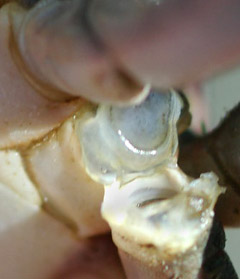
Autotomy membrane protecting crab from blood loss after shedding a limb in Hemigrapsus nudus, purple shore crab. Photo from A Snails Odyssey.
If crabs were built like humans, dropping an arm or a leg would mean certain death, but crabs have a special system built into their anatomy that enables them to do this safely. A special muscle contracts when the crab decides to ditch a leg or a claw, causing the leg to snap off in a predesigned location within just a couple of seconds. The wound is quickly closed with a protective barrier to keep the crab from bleeding to death (more information on Snail’s Odyssey). This is a little like how our bodies form clots to stop blood loss, but the difference is that this can only occur in a particular spot at the base of each leg of the crab.
While it seems like a shame to lose a leg or a claw, crabs do have the ability to grow a limb back – eventually. Crabs can only grow when they molt, and they cannot produce a full sized claw in a single molt. It takes crabs about three molt cycles to get their regrown limb back up to snuff. For young crabs, regrowth is quicker than for large crabs, because small crabs can regrow proportionally more claw with each molt and because they molt more frequently. Adults sometimes molt only once per year, however, so losing a limb is a serious problem. In addition, all crabs reach a terminal molt, a final stage of life when they will never again shed their shell for growth. If a crab that has reached its terminal molt loses a limb, that limb will never regrow.
This is why “claw poaching” is illegal in our area. Poachers take the claws of crabs like red rock crab, which are known for their big meaty muscular pinchers, but toss the crab back to circumvent catch limits. Perhaps poachers assume they are not doing any harm, because the crabs can regrow their claws. But not only is regrowth unlikely for a large crab, but it can also prevent the crab from mating, and, even worse, it can directly kill the crabs. When the claw is ripped off faster than the crab can autotomize, the limb is often pulled out of the body cavity, taking with it the particular part of the leg designed to stop the bleeding. Crabs that are roughly handled to remove claws can therefore bleed to death.
Regrowing limbs is no easy task either, because growth depends on the crab being able to eat, and eating depends on the crab…having claws. If the crab has lost both claws, this is very tricky indeed. Retaining at least one claw seems like a huge asset, but it turns out it depends on which claw.
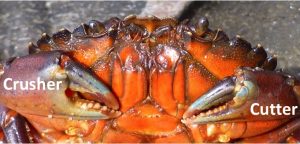
A female European green crab from Maine, showing off her “dimorphic claws”. Her right claw is taller top to bottom, giving greater mechanical advantage for crushing. The more slender left claw is her cutter. Photo: E. Grason
Compensating for Claw Loss
Not all claws are created equal, even for an individual crab. This is because many crabs have some level of differentiation between their two claws. While you might be familiar with the dimorphism in the claws of lobsters, or fiddler crabs, European green crabs also have two types of claw: a cutter and a crusher. The crusher is, as you might expect, the more muscular claw, and like your biceps, the claw that is stronger is often bigger top to bottom. The more slender claw is the cutter, used to help in manipulating food and in tearing flesh. You might also notice a difference in the bumps on the inside of the claw, what crab scientists call dentition. Those bumps concentrate the force of the crabs pinch to small area, and help them cut (sharp bumps) or crush (rounded bumps) their prey. The green crab crusher has wide dentition that looks a lot like our grinding molars. The cutter has smaller bumps that look more like the scissoring teeth of a dog.
Even though these differences seem fairly subtle to us, they can make a big difference to a European green crab. It turns out, if you have to lose a claw, you really don’t want to have to do without your crusher claw. A recent study tested how well European green crabs missing either a cutter or a crusher claw were able to feed themselves compared to crabs with both claws intact. For some types of prey, losing the crusher claw meant the crab was nearly helpless, unable to break open any of the oysters offered. On the other hand (or “claw”, groan), if the crab lost the cutter claw, it barely missed a beat, needing only the remaining crusher to crack open just as many oysters as a crab with both claws (you can read the research). Loss of a crusher claw, could make life harder for a green crab, but perhaps not impossible. Green crabs are known for being flexible eaters, so a crab down a crusher might switch to something easier to subdue, such as worms or even seaweed.
Also like humans, European green crab populations are biased when it comes to right-left asymmetry; nearly all crabs are “right-clawed” – meaning the crusher claw is on the crab’s right. However, this can switch over the course of the crabs life if the crab loses the right/crusher at some point, i.e., the cutter becomes the crusher throughout several molts as the crab regrows the other claw.
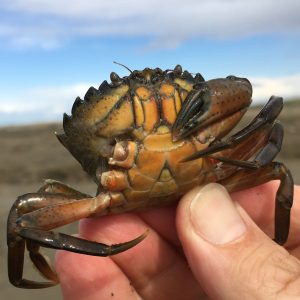
Male European green crab captured at Dungeness Spit this summer, showing loss of right/crusher claw and first right walking leg. Photo: Allen Pleus/WDFW
Clawless Carcinus
Losing a crusher is bad news for a crab, but could it be good news for an invasion? At Crab Team, we keep an eye on how much limb damage European green crab have when we find them. This crab was found at Dungeness Spit, missing a crusher claw and first walking leg on the right side. The crab in the header image was captured at Padilla Bay this April, a rather poor specimen missing both claws, and both of the first set of walking legs. We prefer to see crabs like this because it means this crab has encountered something trying to eat it or fight with it. It also means that it’s less of a threat to native crabs and clams!
In previous research in California, Crab Team member Sean McDonald and his colleagues observed that European green crabs living near larger species of rock crabs (multiple species of the genus Cancer) frequently had damaged or missing claws and legs, while crabs living in marshy areas where rock crabs don’t go were more likely to be unharmed.
Of the European green crab captured on Washington’s Salish Sea shorelines so far (slightly more than 100 to date), roughly one out of every five crabs had some type of limb damage, either to walking legs or claws. Half of those had damage to one of the claws, and at least half of that group involved the right/crusher claw, meaning that at least 5% of European green crabs in our area are likely not very good at feeding themselves. How does this compare to other populations of green crab around the world? The frequency of clawless crabs here is similar to field surveys conducted in the Gulf of St Lawrence, on the eastern seaboard of Canada, but substantially lower than has been observed in other parts of the world, including California (greater than 50% according to research).
Lost claws matter not just to the individual crab, but also to the population of crabs, and to the impacts of that population on native critters. Figuring out why there is variability in limb damage might help predict how claw loss could impact our own shorelines.
– Emily Grason
Species Name: Multiple species of Thalassinidea
Size: Varies by species, but can be up to 6″ (150mm)
Distinguishing Features: “Lobster-like” shrimp – dorso-ventrally flattened with large abdomen and broad tail fan. Hairy walking legs, often a pale white, pink, or gray. More pronounced claws than “true shrimp”, may be uneven in size.
Kings of the Mud: The Salish Sea’s Burrowing Shrimps
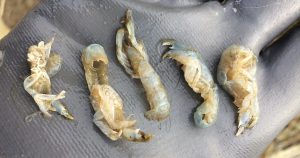
Molts from U. pugettensis, showing how it got its common name – the blue mud shrimp. Unlike N. californiensis, the claws are similar in size and look more like those of a praying mantis than a crab. Photo: J. Adams
Ever find that weird molt that’s not very crab-like but odd for a shrimp? Have you kicked up a creepy, soft, yellow/orange critter while slogging through the mud? Have you suddenly sunk to your knees in what looked like a relatively firm (albeit holey) beach? You’ve probably seen volcano-like mounds on the beach, or you may have thrown a yabby on a fishhook. Welcome to the Salish Sea underground, home to a trio of unusual, ecologically important, economically complex, otherwise cool crustaceans – the bay ghost shrimp Neotrypaea californiensis, its less common close cousin the giant ghost shrimp N. gigas and the blue mud shrimp Upogebia pugettensis.
Ghost and mud shrimp are collectively called burrowing shrimp because of their remarkable adaptations to living in the relative safety of the seafloor. They can burrow arm’s length into the substrate, rivaling the great geoduck for digging deep. Unlike the geoduck, these busy burrowers are constantly moving mud, water and themselves, creating a very active environment that aerates the substrate, enhances nitrogen fixation and provides habitat for other organisms. If you’re looking to put your weight on the beach surface, however, such Swiss cheesing of the seafloor can definitely change the stability under pressure.
Happy Homemakers
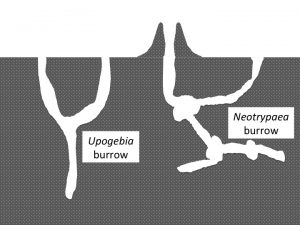
Upogebia typically has a simple Y or U-shaped burrow, while Neotrypaea has a more complex branching shape, extending horizontally, with “turn-around” chambers. Diagram after Swinbanks & Luternauer 1987*
At the beach surface, mud shrimp leave little more than holes to hint at their subsurface accommodations, while ghost shrimp at least give us a distinctive volcano to appreciate. The burrows below the surface are different as well, with mud shrimp creating a U or Y shaped tunnel nearly up to a meter long, while ghost shrimp build a bit more of a catacomb about half as deep but up to a meter wide (watch ghost shrimp excavation in action!). In both cases, a pair of holes at the surface help with water movement through the tunnels. They filter detritus, small bits of organic matter, and diatoms – tiny algae in glass houses – as they work their tunnels and move water through. The organics sustain them, though their guts are largely filled with sand.
Only the right substrate will do for burrowing shrimp: too hard makes burrowing difficult and detritus harder to sift from the sediment; too soft and the walls come crumblin’ down. The sweet spot is a little different for ghost and mud shrimp species. Even though they can overlap, ghost shrimp tend to live in sandy substrate with a bit of mud, while mud shrimp like their lair to be a bit more compact and muddy. Consequently, ghost shrimp also tend to live a bit higher on the beach while mud shrimp can enjoy the mudflat.
Hotel Californiensis
Burrowing shrimp do all this work for their own benefit, but they also make very good landlords in a crowded market. By engineering livable below-ground space, burrowing shrimp create habitats for critters that otherwise couldn’t survive very well. Tenants from several branches of the tree of life take protection in burrowing shrimp tunnels – a remarkable example of how biology can find creative solutions to surviving in a bug eat bug world. A sort of wormy creature, called a phoronid, incorporates its tubes along the mucus-lined sides of mud shrimp burrow. The mud shrimp can still move easily up and down the burrows while the worm gets a safe seat and a regular supply of soup à la Salish Sea. A small goby fish will use burrowing shrimp burrows, as will a scale worm (a relatively short, armor-plated worm), a pea crab, a close cousin called the hooded shrimp, and a clam species that lives in the mud at the edges of the burrows. The clam (Cryptomya californica) would normally need to have its body near the sediment surface, so its short siphons could reach water, but close proximity to the sediment surface also makes them more readily available to predators. By living on the edge of the burrowing shrimp burrow, the clam can stick its short siphons through the burrow walls and pump water for its nutrition and oxygen needs while the shrimp keeps water moving in the burrow. Others simply uses the burrowing shrimp itself as a substrate…
Parasite Party
The burrow isn’t the only shelter the shrimp share. Their own body is home to a variety of much ruder guests. By clamping directly onto the underside of the ghost shrimp, a small commensal clam is able to use the constantly refreshed water of the burrow and live the dream of being mobile. Tiny, bright red copepods can also be found on ghost shrimp. They don’t appear to be doing harm to their host but certainly don’t respect personal space. The really obnoxious relatives that refuse to leave are the isopods.
The native ghost shrimp isopod (Ione cornuta) and the invasive mud shrimp isopod (Orthione griffenis) live on their host’s gills, sucks its blood and leaves an unsightly bulge on the shrimp’s side. The female isopod is large and broad, while the male is small and narrow. Both are rather creepy, a sentiment not improved upon by their status as a castrator. In Washington about 7 of every 100 ghost shrimp examined had the isopod. The blue mud shrimp aren’t as lucky. In a study of Oregon’s Yaquina Bay, nearly every large mud shrimp was infested with the isopod.
Food for Giants
Even though burrowing shrimp can rule over their tide flat for a decade or more, their burrows don’t ensure safety. Once in awhile, the emperor visits to clean house. Gray whales scoop impressive pits along the shoreline sifting out burrowing shrimp by the millions. In an assessment of gray whale burrowing shrimp harvest, Washington Department of Natural Resources scientists estimated about 10 gray whales consumed about 124,000,000 burrowing shrimp during their 2015 visit to the Whidbey Basin. Whales aren’t their only predator though. Burrowing shrimp made up ⅓ of the diet of staghorn sculpin (Leptocottus armatus, #2 on the all-time Crab Team leaderboard) in a Grays Harbor study. They are an important food source for white and green sturgeon too, with the bellies of young green sturgeon from Willapa Bay containing about 50% ghost shrimp biomass. Cage out these predators and burrowing shrimp can thrive. On top of being eaten, healthy eelgrass beds have been shown to limit the success of burrowing shrimp, making it difficult for them to dig tunnels among the roots.
Controversial Crustaceans
Burrowing shrimp are currently as mired in controversy as they are in the mud. As they riddle and soften the sea floor, heavy clams and oysters sitting on or near the surface may sink or be buried under ghost shrimp’s large mounds. It’s suspected that numbers and local distribution of burrowing shrimp have taken advantage of an ecosystem out of whack and expanded in Washington’s outer coast estuaries, creating significant conflict with shellfish production and a decades-old battle to keep the shrimp ‘at bay’ in aquaculture areas. The controversy has erupted recently as Washington’s shellfish aquaculture industry transitions from an older control measure and seeks another way to keep their clams and oysters from sinking (link). At the same time, burrowing shrimp have been harvested and sold as prized fishing bait. In 2015, approximately 4,000,000 burrowing shrimp were harvested by commercial and tribal operations in the Whidbey Basin. Love ‘em, hate ‘em or a little of both, burrowing shrimp are as interesting and influential as they are unusual.
–Jeff Adams
*We try to connect you with the research our information is based on. We apologize, however, that some articles require a subscription to access.
Sampling at site 516 is a walk in the park, but only literally.
On the shore of northeast Camano Island, volunteers at Iverson Spit County Park walk the Hobbit Trail each month of the sampling season, carting their traps and gear out to the marsh site in a red wagon, noting mushrooms and birds along the way. But once they reach the saltmarsh, the team gets down to the literal nitty gritty. Iverson Spit is one of the more demanding sites in the Crab Team monitoring network. The channels that offer excellent potential green crab habitat are deeply incised, and climbing/sliding down into them to set the traps is not easily done. In truth, the difficulty is not so much getting down into the channels, but getting back up out of them.
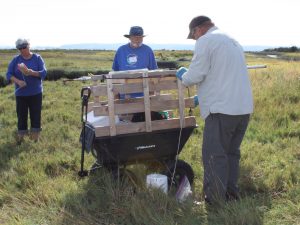
Crabbin Wagon, featuring all-terrain tires, independent dual suspension, and pop-up ergonomic sorting table. Customized by Dick Freauff. Photo: K. Ambrus
The volunteers who have worked at Iverson have used no small amount of ingenuity to address this challenge during the three seasons the site has been trapped. Committed to the importance of this site, they rigged up a system whereby traps were set and retrieved with a gaffe, weighted, and tethered to shore so that they stayed put overnight. The team even worked out a way to bring up water with a bucket on a rope to keep the fish happy during sorting. While this creative routine worked, it was still fairly laborious, and the group turned to Crab Team for a solution.
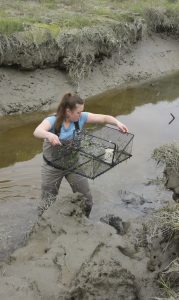
Maggie Taylor, natural resources staff at the Stillaguamish Tribe, was mudpuppy during Julys sampling. Here she ably retrieves a Fukui trap from the channel at Iverson. Photo: K. Neymeyer, Stillaguamish
“What we need is a ‘mudpuppy’,” said Crab Team program coordinator Emily Grason, “someone on the team who is comfortable climbing down into the channels, and who can be the dedicated trap setter and retriever.”
Iverson Spit found their mudpuppy partners in the Stillaguamish Tribe. Members of the Tribe’s natural resources staff joined the volunteers this year, and send at least one field technician in chest waders into the channel each month to set and retrieve traps. Robbie Lamb, Fisheries Technician with the Stillaguamish, often leads the charge into the mud at Iverson, hoisting the traps up to the bank so the catch can be counted and measured. The Stillaguamish staff also monitor a separate site nearby, at Davis Slough, as part of the Crab Team early detection network.
The current team of volunteers at Iverson has members from multiple stakeholder groups: stewardship organizations, management, and volunteers. The group not only finds this collaboration enriching, but the partnerships on the Iverson team are also a microcosm of Crab Team’s citizen science ethos. By connecting scientists and resource managers with engaged volunteers, Crab Team monitoring can cover more ground, and survey more intensively, ultimately creating a more effective early detection effort. Volunteers who participate get direct access to scientists and managers doing the work to protect the shorelines that volunteers care about, and they get to participate side-by-side in relevant conservation work. As one of the Iverson team members put it, “I like to do this activity, because we are engaged in something meaningful – trying to catch the critters before they do too much damage here. It’s like we are on the front lines battling a fire in some way – although for us a lot easier.”
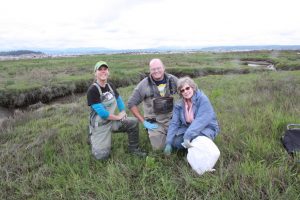
Stillaguamish natural resource staff Anya and Robbie join volunteer Shirley at Iverson in 2017. Photo: K. Ambrus
Our first partners on Camano were the Sound Water Stewards. In 2015, Crab Team’s pilot year, this stewardship group (Island County Beachwaters at that time) was one of the first to jump in the mud with us and undertake local monitoring. Many Sound Water Stewards participate in various citizen science projects along Camano and Whidbey Island shorelines as partner projects for the organization. During the first year, we only had the capacity to launch one site on all of Camano, and the interest from the Sound Water Stewards exceeded the space we had. One of the first sampling trips, the group captain was overseeing eight volunteers! While many hands can make for light work, it can be a challenge to make sure everything happens smoothly when there is so much going on at once. Since then, Crab Team has added another site on Camano, at Elger Bay, and trained many others who are eager to support the effort to patrol the beach for European green crab molts.
Even with all we’ve learned about European green crab in the Salish Sea over the past three years, the outcomes are never certain. One thing that is clear, however, is that protecting shorelines will require a long-term commitment and a lot of dedication. The Salish Sea is fortunate to have dedicated crews like the team at Iverson Spit, who have met the challenges of surveying through partnerships, creativity, and sheer grit – both figurative and literal.
–Emily Grason
Photo Gallery
We love to get the virtual experience of monitoring with all of the Crab Team volunteers. Do you have a photo to share? Send it to crabteam@uw.edu. (Click on arrows to scroll, and photos to enlarge for more detail.)
